“I once walked through the burial grounds on the Surry Hills, in the commencement of Spring, just as the flowers were beginning to bloom forth in all their beauty…”
Bridget Flood was in the same situation too many of us have found ourselves in all too often: stranded at Sydney’s Central train station, hopelessly late. The big difference is that she was waiting there for over 60 years.
As we’ve previously learned, 1820 was a good year to die in Sydney. Rather than ending up beneath the public piss-pot that was once the colony’s first burial ground, you could find yourself in a brand new plot freshly dug at the just-consecrated Devonshire Street Cemetery.
Chosen for its abundance of space and central (heh) location, the area bordered by Elizabeth and Devonshire streets was chosen to replace the Old Burial Ground as Sydney’s premier final resting place. Quartermaster Hugh McDonald, 40, was the first lucky stiff to be buried there following his death in 1819. Long waiting lists…so Sydney so chic.
“It was early in the morning when I commenced rambling amongst the tombs, the dew had not yet been dissipated by the genial rays of the invigorating luminary, and the cool fragrance of the atmosphere had not yet given way to the noon-day heat…”
Bridget Flood died in October 1836 at the age of 49 and, like virtually all deaths in Sydney at the time, was interred at the Devonshire Street site. Quoth her headstone:
“Pain was my potion
Physic was my food
Groans were my devotion
Drugs did me no good
Christ was my physician
Knew what way was best
To ease me of my pain
He took my soul to rest.”
They don’t write ’em like that anymore. And rest she did, as did all those buried at Devonshire Street Cemetery well past its 1867 closure.
Although steadily employed by the city’s dead between 1820 and 1866, the nail in the coffin (heh heh) for the cemetery was the latter year’s introduction of the Sydney Burial Grounds Act (NSW), which prohibited burials “within the city of Sydney from 1 January 1867, with the exception that persons with exclusive rights of burial at that date could still be buried on application to the Colonial Secretary who needed to be satisfied that ‘the exercise of such right will not be injurious to health’“. Phew. Just tie some rocks to me and throw me in the harbour!
You’d think this act would be in anticipation of some kind of grand plan for the burial ground, but no. With the exception of infrequent additions to family plots as outlined by the overly wordy act (and even these ceased in 1888), Devonshire Street was largely ignored by the growing city while new sites like Waverley Cemetery and the Rookwood Necropolis served the public’s burial needs.

Prince Alfred Park’s Exhibition Building looms large. Devonshire Street Cemetery, 1901. Image courtesy Royal Australian Historical Society.
By 1900, its advanced state of neglect and decay reflected its residents and disturbed the public:
…although it wasn’t all bad:
“In short, it was exactly such an hour as an imaginative or sensitive being would delight to rove about, and lose himself in the regions of fancy…”
It wasn’t long before some of the more opportunistic voices began to speak out about the the site’s real estate value:
And as early as 1888 there were rumblings about how best to use the land:
It made sense, given that Central Station’s predecessor, ‘Sydney Station’, lay opposite the cemetery along Devonshire Street.
Since 1884, Sydney’s existing rail network had been under the stress of increasing traffic and a limited reach (sounds familiar, doesn’t it?). Sydney Station was constantly receiving upgrades and additional platforms, culminating in a messy setup of 13 train platforms and numerous tram sheds (sounds familiar, doesn’t it?). The city’s railway commissioners initially struggled to decide upon a plan for the future which would provide Sydney with a central hub expansive enough to extend the rail network to the suburbs (sounds- never mind).
An 1897 royal commission proposed the resumption of Hyde Park for use as the central terminal and, to counter the public outrage over the loss of parkland, the Devonshire Street Cemetery would be converted into a park. For a time this plan seemed to be a go until the unexpected death of Railway Commissioner E M G Eddy (of Eddy Avenue fame) that same year. This forced a literal return to the drawing board, where it was decided that it was probably easier to resume just one giant park instead of two. Nice thinking, guys.
In January 1901, the Department of Public Works served notice that anyone with relatives buried at Devonshire Street were to front up and make known their desire to have the remains reinterred at other cemeteries by train, with the cost to be borne by the NSW Government. These days, they’d just tell you to bring a shovel.
Unfortunately, these relatives were given a strict time limit of two months to act, and by the end of that time, only 8,460 bodies had been claimed (not among these was Eddy, who had been buried at Waverley following his death). This left 30,000 remains unclaimed, most of which were transferred to other cemeteries anyway, but due to the rushed nature of construction and given they did such a bang-up job the last time, it’s safe to say there are more than a few commuters at Central waiting for a train that will never come.
With that many bodies to exhume, you can imagine just how many creepy stories must have come out of the venture. Here’s just one:
The reason for the rush was that Melbourne had started work on their Central equivalent, Flinders Street Station, that same year. Sydney was determined to get the drop on Melbourne this time, as Flinders predecessor ‘Melbourne Terminus’ had been Australia’s first city railway station back in 1854, pipping Sydney by a year. The Devonshire Cemetery site had been completely cleared by 1902, and stage one of Central’s construction, which aimed to have the station operational, was completed in 1906. On opening day, the new station featured…13 platforms. Despite being twice the size of its predecessor, this was no improvement, and did nothing to alleviate Sydney’s transport woes (but then again, what ever does?).
“I directed my footsteps to a cluster of tombs on an eminence, which was thickly covered with green and blooming geraniums…”
But the unexpected fruit of the Department of Public Works’ labour was the emergence of commercial activity in the areas surrounding the new station. Its proximity to the city made department store shopping for those out in the sticks a treat, with Grace Bros., Marcus Clark, Anthony Hordern, Bon Marche and Mark Foy all within walking distance of Central by 1908. The Tivoli and Capitol theatres became entertainment meccas for those starved of entertainment in the ‘burbs.
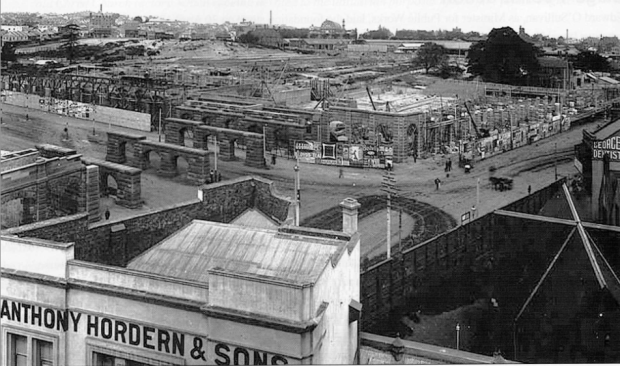
Anthony Hordern awaits new business during Central’s construction, April 1903. Image courtesy ARHS Rail Resource Centre.
The station itself was hardly the thing of beauty its early designs had suggested, with the rushed development cycle omitting many intended features – least of all Central’s iconic clock tower, which wasn’t completed until 1924.
The construction wasn’t just focused on making sure the station would be operational before Flinders Street, though; there was particular care taken to ensure no trace of the Devonshire Street Cemetery remained, going so far as to completely eradicate Devonshire Street west of its intersection with Elizabeth. Other structures that once stood on the land now occupied by Central and its surrounds – the Belmore Police Barracks, the Benevolent Asylum, the womens refuge – have similarly been lost to time.
“I at first almost forgot the ravages of the grave in contemplating the enchanting appearance of the place.” – James Martin, 1838.
Today, nothing remains to remind commuters of the morbid nature of Central’s past. The cemetery itself was largely situated underneath today’s platforms:
Devonshire Street Tunnel, once Devonshire Street, runs directly underneath the path once carved between the cemetery and Sydney Station, depositing Surry Hills pedestrians into Railway Square amid el-cheapo bargain shops, youth hostels and fast food joints.
Also in Railway Square is a series of plaques designed to inform passers-by on the history of Central Station and railway in NSW. The cemetery is mentioned in passing (heh).
The uneven terrain of Belmore Park perhaps provides us with the nearest idea of what the Devonshire Street Cemetery was like in its natural state as is possible today, although even it has a sordid and ugly past as an open gutter for the refuse of the nearby Belmore Produce Markets and Paddys Markets.
Rookwood Necropolis, Eastern Suburbs Memorial Park, Woronora Cemetery and many others were the recipients of many of the (not so) permanent residents of Devonshire Street, but none feature as striking and immediate a memorial as the tiny, eerie Camperdown Memorial Rest Park. Here, amongst the sombre atmosphere of tombstones and gloomy, gnarled trees lie what were once the gate posts met by visitors to Devonshire Street. These were removed along with everything else in 1901, and mysteriously disappeared from existence until 1946, when…
It seems almost sacrilegious that thousands of commuters tread all over this once-consecrated ground every day without any kind of marker to signify what was and who mattered, even if it was nearly 200 years ago. C’mon, NSW Government! They’re even in the right electorate! Meanwhile, to the 30,000 Sydneysiders scattered to the four corners by the winds of progress, the term ‘final resting place’ has little meaning.
Finally, here’s a fascinating account of a visit to Devonshire Street Cemetery just as its demolition was beginning. It originally appeared in the Clarence and Richmond Examiner, October 1 1901.
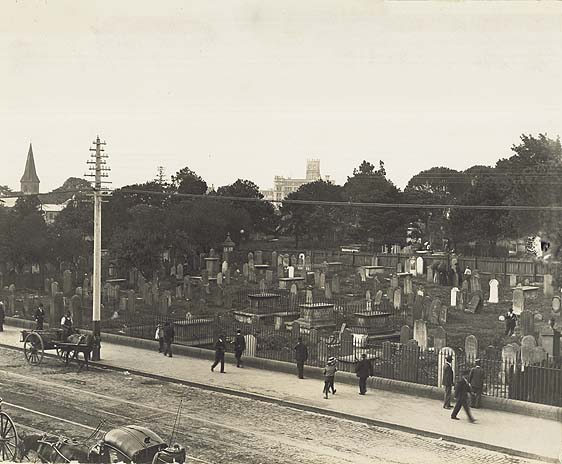

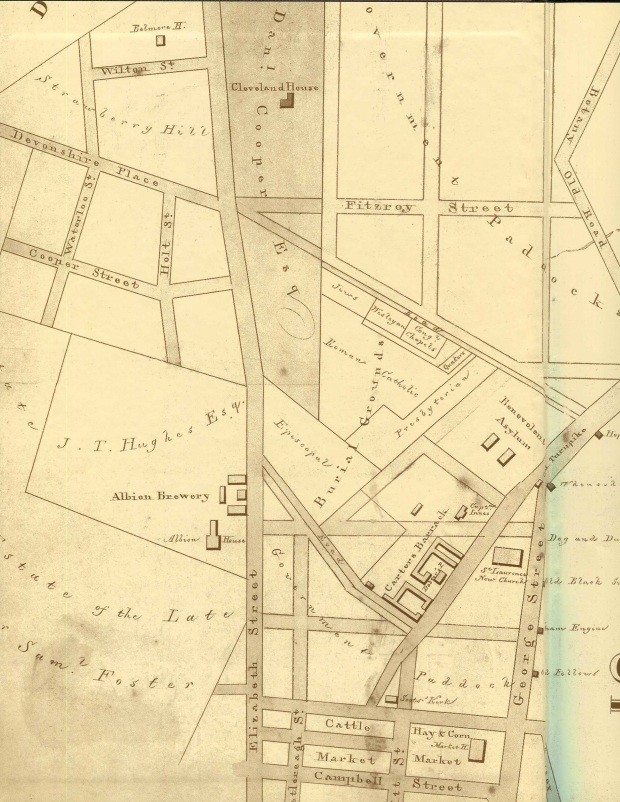





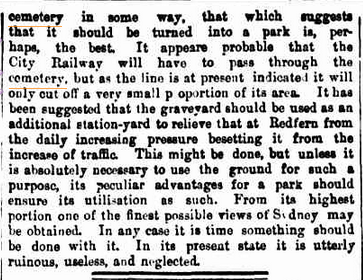
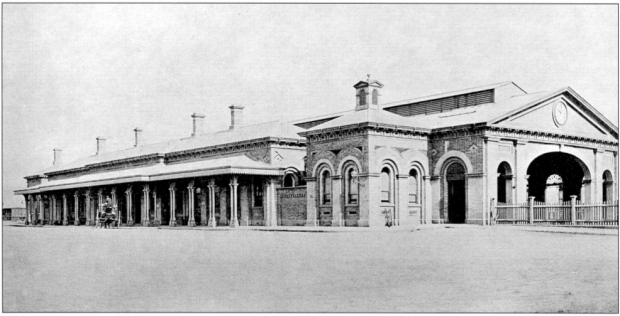
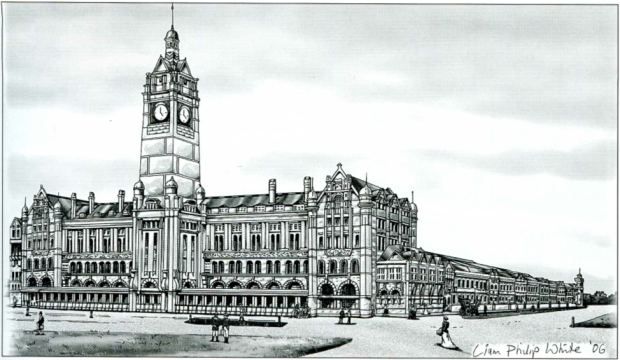




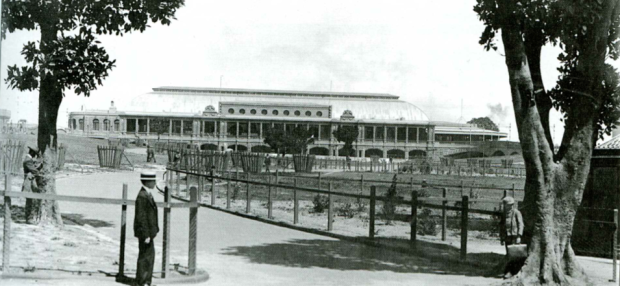



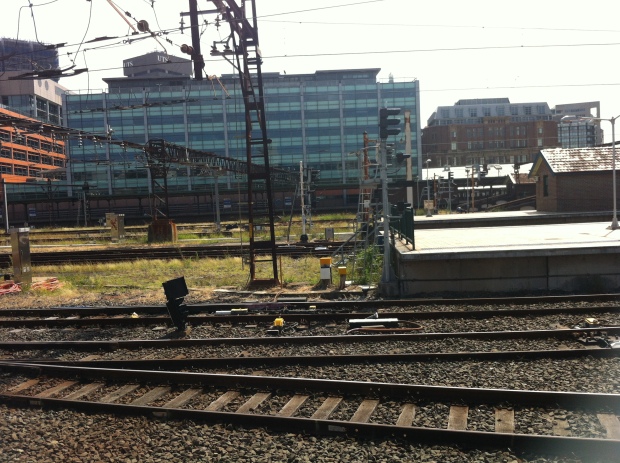





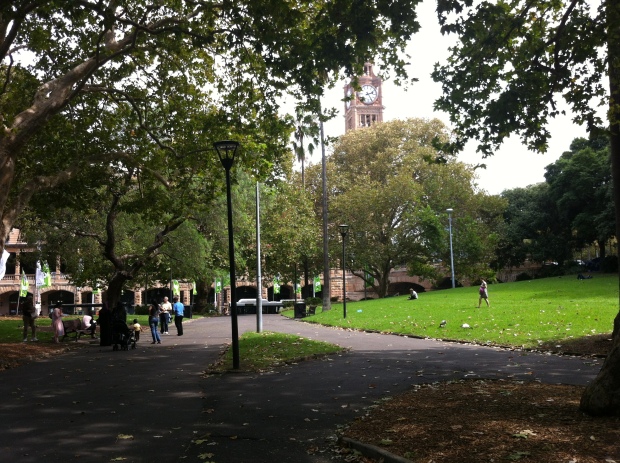





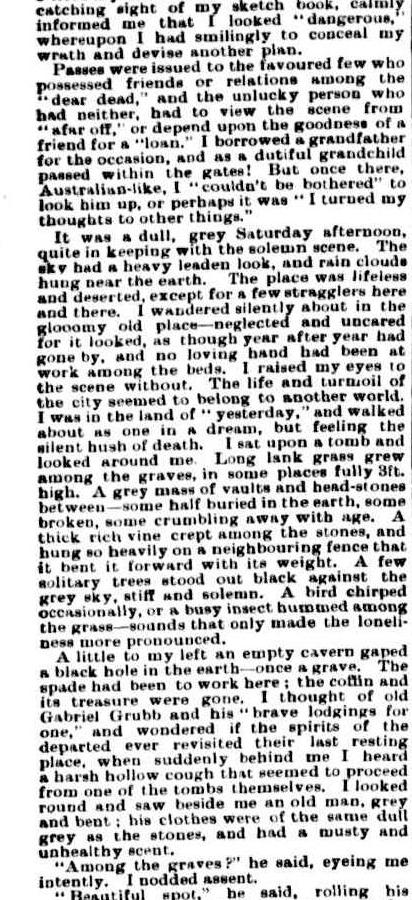












Thank you for another fantastic article. I had just been wondering when the next installment was due on this blog and it has been well worth waiting for! Really enjoyed reading this (as always). I can add a small piece that might be of interest. My father’s career was/is in earth moving and the company he worked for was contracted to work on the Eastern Suburbs Railway in the mid 1970’s. There was a body dug up from the old cemetery during the excavations. The police had to be called to rule out foul play. It closed down the worksite for the day.
Very interesting reading, after living almost all my life in the Eastern Suburbs of Sydney, didn’t even know that a cemetery ever existed in Devonshire Street.
Great history for the younger generation to know and read about.
Interesting reading Michael, I stumbled across your site whilst looking for details of my GGG Grandmother who I believe was buried at Devonshire St in 1860 and was pleasantly surprised to see her husband’s grave in your photo of Camperdown cemetery (the obelisk in the middle of the photo – Samuel Hopkinson Turton d.1870). He was buried in the Old Balmain Cemetery and the monument was moved to Camperdown in the 1930s when Balmain cemetery was removed and turned into the pioneer park currently situated on Norton St Leichhardt. He was not buried with his wife so I can only assume he missed out when they closed the cemetery in 1869.
Great blogg,
Great read about the first resting place of George Bolton, Convict turned publican in Elizabeth St’s Cross Key’s Inn, Sydney. Baptised in 1804 in Hinton Charterhouse, Somerset and died in Sydney being buried in Sandhills Cemetery in 1834. We will meet again! From his Great x 3 granddaughter Paula-ann Hallinan 😉
There where 3 cemeteries before the 1900.s //
1st being the Sydney town hall..all that block..
2nd being deveonshire street..
3 rd being the cemetery covering VICTORIA PARK next to Sydney uni..opposte the old grace bros store..
the third was used to transfer most of the town hall dead when the town hall was being built..they also put dead in the existing Devonshire cemetery
it was then that sir francis greenway started on the camperdown st stephens cemetery.. some dead where put in from Devonshire when the railworks went throught there. the former Victoria park was emptied and all where re intered at rookwood same for Devonshire most went to rookwood a few went to botany.. the newst cemetery after that was Clovelly and vacluse.. rookwood and boatany are still the largest in Sydney and westerb Sydney.
recently botany has expanded to the other side of the road taking up the big hill above the old power station location.
Wow! what a great article, thank you so much.
I could not believe it when I discovered the 1842 map of South Sydney and its details about Cleveland House. A dear relative of mine’s Great Grandfather was born in Cleveland house. The Cooper’s were privileged citizens of Sydney with connections to Governor Macquarie from prior military service in England. Daniel Cooper was elected to the first NSW Government and became the First Speaker. The family grew to be rich, with land grants in Sydney and further afield in the Lake Bathurst Area of NSW.
Thank you so much for including that map in your wonderful article.
Judy Mayo
And thank you for your story, Judy!
No doubt a job for Ghostbusters! Does anyone have some ghost pictures to share?Once upon a time I used the station for work and the walk underground would leave an eerie feeling in me.This little article goes a long way in explaining those spooky sensations, lol.
My husband’s early relatives were moved from Devonshire to Waverly
What an excellent site thank you. I had a relative with “his remains were removed from the Devonshire Street Cemetery…”. This site fills in all the unanswered questions with so many great photographs.
has anyone got the list of people who were buried at Devonshire cemetery
I actually have that list, Richard. Email me.
Can I have copy too?
Get in touch.
Could I get a copy too, please? When the family arrived in 1838 a daughter died that year aged 1 or 2 yo. My grandfather had made enquiries and been told she was buried in the old sydney burying ground, but that stopped burials in 1919 or Jan 1920. Apparently the St phillips records show her death.
It would be good to resolve this.
I can’t believe it you have a list. I’ve been searching for Thomas Pidding died 1840 he was a doctor who came to live in Australia 1829. His brother George Raymond Pidding is my greatx3 grandfather. Could you please let me know if he’s on your list.
I’m sorry Glenda, I’ve had a look at the list and I could not find a Thomas Pidding. It’s not an exhaustive list but certainly it would seem he wasn’t moved to Bunnerong or Rookwood.
Michael, May I please get a copy of your list or if too big, a copy of where Michael McGrath DOD 1852 would be listed? He is my GGGG Grandfather, a convict from Ireland and was suppossedly buried there. I would be so so greateful. Thanking you in anticipation.
Sorry, that was 1819 or Jan 1820.
Fascinating.Sydney is so interesting.Thanks.
Interesting article ..trying to locate information on William Galvin who was buried in this cemetary but was buried there in 1873.6 years after closure .so I am gathering the odd few did get buried there after closing.William was 89 when he died his wife Margaret died in 1853 and also was buried there .She was re buried at Botany but no mention of William being reburied..would love to find out what happened to him as he was the 2 nd person in charge of the Australian museum from 1831/1835. Any assistance would be appreciated .regards Col
Tonight I attended the Harp in the South at the Sydney Theatre Company and naturally started researching Surry Hills. I new of them he old Devonshire Street Cemetery from my father. I’d love a copy of the Devonshire Street Cemetery list if you still have it or if you could tell me where you got it. Thanking you Lorraine
I have a great grandfathers1st wife buried at central railway Station St Lawrence church
in 1848 would she be on this list . She was Elizabeth Giddins nee Carter
You need to check out the book: “Sydney Burial Ground 1819-1901” by Keith Johnson. It has lists of marked graves. Unmarked graves don’t appear to be listed anywhere as far as I have found.
thanks Sue I will look for that book. I am not sure if is a marked or unmarked grave. We only have the information from my heritage
Marlene
Actually if you are on facebook, there is a group called Devonshire Street Cemetery. I think there was someone who has the book and could look it up for you.
Hi Marlene,
I have the book, but I was unable to find that name on any of the lists within.
My 4xGreat Grandparents Patrick Keighran died 1819 and Catherine Keighran died 1816..infant Catherine Keighran died 1816..all buried Old Sydney Cemetery..but can not trace a paper trail if family managed to lay to rest later in another cemetery. All three are on the spreadsheet for old Syd Cemetery …have done basic searches on internet.
Too late for Devonshire St Cemetery
Oops, not too late. I was thinking 1919. Pls ignore my comment. ;/
I’m curious where all the headstones went?
Dee 🤔
a few went to Botany Cemetery – there is a historic headstone section there. Cheers Paul Howe
Just stumbled upon this while looking into Central platform 26 and 27. Thank you for the fascinating info — I’ll never see the tunnel crossing Central the same again!
[…] Past Lives of the Near Future […]
What a wonderful account. The burial certificate (1851) of my GGGG grandfather Daniel Magennis indicates his abode as Benevolent Asylum and location of burial “parish of St James, in the county of Cumberland” I could not confirm his actual location but I did find him (as Daniel McInnes) on a Devonshire St reinterment list to Gore Hill.
My GGGG Grandfather was Michael McGrath an Irish Convict. He was also in the Benevolent asylum 1851 dying in 1852 and buried at Devonshire Street Cemetery. They may have known each other…